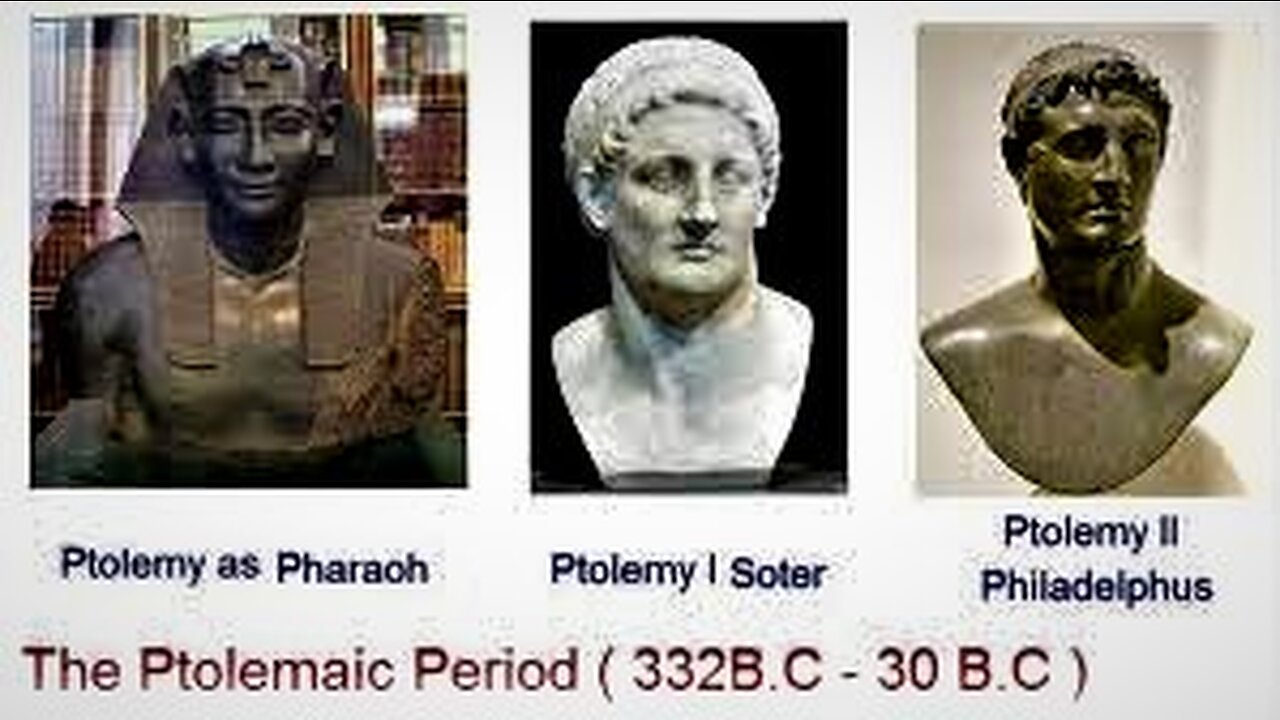Premium Only Content

Ptolemaic (Fake) Pharaohs in Zwitzerland
The Persian occupation of Egypt ended when Alexander the Great defeated the Persians at the Battle of Issus (near present day Iskenderun in Turkey) in November 333 B.C.
The Egyptians, who despised the monotheistic Persians and chafed under
Persian rule, welcomed Alexander as a deliverer. In the autumn of 332 B.C., Alexander entered Memphis, where, like a true Hellene, he paid homage to the native gods and was apparently accepted without question as king of ancient Egypt.
Also like a true Hellene, he celebrated the occasion with competitive games and a drama and music festival at which some of the leading artists of Greece were present.
From Memphis, Alexander marched down the western arm of the Nile and founded the city of Alexandria.
Then he went to the oasis of Siwa (present-day Siwah) to consult the oracle at the Temple of Amun, the Egyptian god whom the Greeks identified with their own Zeus.
After Alexander's death of malarial fever in 323 B.C., the Macedonian commander in Egypt, Ptolemy, who was the son of Lagos, one of Alexander's seven bodyguards, managed to secure for himself the satrapy (provincial governorship) of ancient Egypt. In 306 B.C., Antigonus, citing the principle that the empire Alexander created should remain unified, took the royal title.
In reaction, his rivals for power, Ptolemy of Egypt, Cassander of Macedonia, and Seleucus of Syria, countered by declaring themselves kings of their respective dominions.
Thus came into existence the three great monarchies that were to dominate the Hellenistic world until, one by one, they were absorbed into the Roman Empire.
The dynasty Ptolemy founded in Egypt was known as the line of Ptolemaic pharaohs and endured until the suicide of Cleopatra in 30 B.C., at which time direct Roman control was instituted.
The early Ptolemies were hardheaded administrators and business people, anxious to make the state that they created stable, wealthy, and influential.
The Ptolemies had their eyes directed outward to the eastern Mediterranean world in which they sought to play a part.
Egypt was their basis of power, their granary, and the source of their wealth.
Under the early Ptolemies, the culture was exclusively Greek. Greek was the language of the court, the army, and the administration.
A canal to the Red Sea was opened, and Greek sailors explored new trade routes.
Whereas many ancient Egyptians adopted Greek speech, dress, and much of Greek culture, the Greeks also borrowed much from the Egyptians, particularly in religion.
In this way, a mixed culture was formed along with a hybrid art that combined ancient Egyptian themes with elements of Hellenistic culture.
Egyptian lawyer sues Netflix over blackwashed Cleopatra ‘documentary’
Egyptian lawyer Mahmoud al-Semary has filed a case with the Egyptian public prosecutor’s office to shut down the Netflix platform in Egypt, following the trailer release of “Queen Cleopatra”, which portrays the last Queen of Egypt as a sub-Saharan African
Al-Semary is demanding that the prosecutor’s office take serious legal action against those responsible, blaming the management of Netflix for complicity in what he called “this crime”. He further demanded that Netflix’s streaming service be banned from Egypt, citing religious values as another reason.
“Most of what Netflix platform displays do not conform to Islamic and societal values and principles, especially Egyptian ones,” he wrote in the complaint he filed.
The lawyer says that the documentary promotes the kind of Afrocentrism which aims at distorting and obliterating Egyptian identity and contradicts the country’s history.
“In order to preserve the Egyptian national and cultural identity among Egyptians all over the world there must be pride in the makings of such work,” reads the complaint, further accusing the documentary and platform management of “forgery”.
Stirring up confusion, spreading false information
Al-Semary’s complaint appears to be a response to an appeal made by former Egyptian Antiquities Minister Zahi Hawass, who called for someone to stand up to Netflix.
“This is completely fake,” said former Egyptian Antiquities Minister Zahi Hawass the preceding week, explaining that depicting Queen Cleopatra as a sub-Saharan African woman was “falsifying facts”, since the last ruler of the Ptolemaic dynasty was of Greek origin.
Hawass said, that aside from the period of the twenty-fifth dynasty, when Egypt was indeed ruled by pharaohs originating from the Nubian Kingdom of Kush, the only connection to Sub-Saharan people was as neighbors with whom Egypt would wage war, as depicted on walls of ancient tombs.
Paintings found in Pharaoh Seti I’s tomb depicting (left-to-right) a Lybian, a Nubian, an Assyrian, and an Egyptian.
In fact, modern researchers with access to DNA samples have suggested that modern Egyptians actually have more in common with sub-Saharan Africans than Cleopatra and others living in antiquity, as pointed out in an article by “Africa Times”, which quotes from “Ancient Egyptian mummy genomes suggest an increase of Sub-Saharan African ancestry in post-Roman periods”, a 2017 paper published by the scientific journal “Nature”.
“Netflix is trying to stir up confusion to spread false information that the origin of Egyptian civilization is Black,” Hawass said.
Hawass said that in recent years a trend has emerged in the West portraying the Egyptian civilization as being Sub-Saharan.
Advertised by Netflix as a documentary, the trailer for “Queen Cleopatra”, directed by Jada Pinkett Smith, wife of the famous U.S. actor Will Smith, depicts Queen Cleopatra as Black, played by actress Adele James.
“If you don’t like the casting don’t watch the show,” James pouted last week.
The pendulum swings
Some films depicting ancient Egypt or ancient Egyptian characters have been conversely criticized for “whitewashing”. But these are no old films, like the 1963 “Cleopatra”, directed by Joseph L. Mankiewicz, where the Queen of the Nile was played by the British-American actress Elizabeth Taylor.
Makers of the children's action film franchise “Night at the Museum” faced criticism for casting Rami Malek in the role of a fictional Pharaoh Ahkmenrah because the actor is not Black.
As accurately observed by his detractors, Malek is not Black. He is Egyptian-American, and his family is Coptic.
Copts are descendants of ancient Egyptians who after converting to Christianity at the start of the Common Era retained that religion, as well as the language of their ancestors, rather than adopting Islam and the Arabic language following the Muslim Arabs’ conquest of the country.
The question of the race of ancient Egyptians was raised historically as a product of the early racial concepts of the 18th and 19th centuries, and was linked to models of racial hierarchy primarily based on craniometry and anthropometry
A variety of views circulated about the racial identity of the Egyptians and the source of their culture
Some scholars argued that ancient Egyptian culture was influenced by other Afroasiatic-speaking populations in North Africa, the Horn of Africa or the Middle East, while others pointed to influences from various Nubian groups or populations in Europe
In more recent times some writers continued to challenge the mainstream view, some focusing on questioning the race of specific notable individuals such as the king represented in the Great Sphinx of Giza, native Egyptian pharaoh Tutankhamun, Egyptian Queen Tiye, and Greek Ptolemaic queen Cleopatra VII.
Mainstream scholars reject the notion that Egypt was a white or black civilization; they maintain that applying modern notions of black or white races to ancient Egypt is anachronistic.
In addition, scholars reject the notion, implicit in the notion of a black or white Egypt hypothesis, that Ancient Egypt was racially homogeneous; instead, skin color varied between the peoples of Lower Egypt, Upper Egypt, and Nubia, who in various eras rose to power in Ancient Egypt.
Within Egyptian history, despite multiple foreign invasions, the demographics were not shifted substantially by large migrations.
Background
In the 18th century, French philosopher, Constantin François de Chassebœuf, comte de Volney, in a set of comments regarding the race of the ancient Egyptians, wrote that "the Copts are the proper representatives of the Ancient Egyptians due to their jaundiced and fumed skin, which is neither Greek, Negro nor Arab, their full faces, their puffy eyes, their crushed noses, and their thick lips...the ancient Egyptians were true Negroes of the same type as all native born Africans".
Volney also said that the Sphinx gave him the key to the riddle as to why all the Egyptians he saw across the country "have a bloated face, puffed-up eyes, flat nose, thick lips – in a word, the true face of the mulatto." He wrote he was tempted to attribute it to the climate, but upon visiting the Sphinx, its appearance gave him the answer; "seeing that head, typically negro in all its features", Volney saw it as the "true solution to the enigma (of how the modern Egyptians came to have their 'mulatto' appearance)".
He goes on to postulate, "the Copts were "true negroes" of the same stock as all the autochthonous peoples of Africa" and they "after some centuries of mixing..., must have lost the full blackness of its original color." Jacques Joseph Champollion-Figeac criticized Volney and called his conclusion "evidently forced and inadmissible".
The leading French scientist of the 18th century, Georges Cuvier, considered the Egyptians to be Caucasian, and it was with Cuvier that Augustus Granville sided in the dissection and first scientific autopsy of an ancient Egyptian mummy in 1825.
Another early example of the controversy is an article published in The New-England Magazine of October 1833, where the authors dispute a claim that "Herodotus was given as authority for their being negroes." They point out with reference to tomb paintings: "It may be observed that the complexion of the men is invariably red, that of the women yellow; but neither of them can be said to have anything in their physiognomy at all resembling the Negro countenance."
In 1839, Jean-François Champollion suggested that: "In the Copts of Egypt, we do not find any of the characteristic features of the ancient Egyptian population. The Copts are the result of crossbreeding with all the nations that successfully dominated Egypt. It is wrong to seek in them the principal features of the old race."
This memoir was made in the context of the first tribes that would have inhabited Egypt, his opinion was noted after his return from Nubia. In 1839, Champollion's and Volney's claims were disputed by Jacques Joseph Champollion-Figeac, who blamed a misunderstanding of the ancients for spreading a false impression of a "Negro" Egypt, stating "the two physical traits of black skin and woolly hair are not enough to stamp a race as Negro":
26 and "the opinion that the ancient population of Egypt belonged to the Negro African race, is an error long accepted as the truth. ... Volney's conclusion as to the Negro origin of the ancient Egyptian civilization is evidently forced and inadmissible."
Gaston Maspero, a 19th-century French Egyptologist, stated that "by the almost unanimous testimony of ancient Greek historians, they Ancient Egyptians belonged to the African race, which settled in Ethiopia."[20] Heinrich Karl Brusch, a 19th-century German Egyptologist stated that "according to ethnology, the Egyptians appear to form a third branch of the Caucasian race... and this much may be regarded as certain".
E.A. Wallis Budge, a 19th-century British Egyptologist, argued that "There are many things in the manners and customs and religions of the historic Egyptians that suggest that the original home of their ancestors was in a country in the neighborhood of Uganda and Land of Punt".[22]
The debate over the race of the ancient Egyptians intensified during the 19th century movement to abolish slavery in the United States, as arguments relating to the justifications for slavery increasingly asserted the historical, mental and physical inferiority of black people.[23] For example, in 1851, John Campbell directly challenged the claims by Champollion and others regarding the evidence for a black Egypt, asserting "There is one great difficulty, and to my mind an insurmountable one, which is that the advocates of the negro civilization of Egypt do not attempt to account for, how this civilization was lost.... Egypt progressed, and why, because it was Caucasian."
The arguments regarding the race of the Egyptians became more explicitly tied to the debate over slavery in the United States, as tensions escalated towards the American Civil War.[25]
In 1854, Josiah C. Nott with George Glidden set out to prove "that the Caucasian or white, and the Negro races were distinct at a very remote date, and that the Egyptians were Caucasians." Samuel George Morton, a physician and professor of anatomy, concluded that "Negroes were numerous in Egypt, but their social position in ancient times was the same that it now is [in the United States], that of servants and slaves."
In the early 20th century, Flinders Petrie, a professor of Egyptology at the University of London, in turn spoke of "a black queen", Ahmose-Nefertari, who was the "divine ancestress of the XVIIIth dynasty". He described her physically: "the black queen Ahmose Nefertari had an aquiline nose, long and thin, and was of a type not in the least prognathous". Petrie was a proponent of the dynastic race theory of the ancient Egyptians.
He believed that a "master race" of invaders from the east, (i.e. Mesopotamia) was responsible for imposing civilization on the "primitive" and "unsophisticated" indigenous Egyptians.
At the UNESCO "Symposium on the Peopling of Ancient Egypt and the Deciphering of the Meroitic script" in Cairo in 1974, the "Black Hypothesis" and the notion of a homogeneous population in Egypt was proposed by Cheikh Anta Diop in his chapter Origins of the Ancient Egyptians. "Numerous objections were made to the ideas propounded by Professor Diop.
These objections revealed the extent of a disagreement which remained profound even though it was not voiced explicitly."
The disagreement was largely due to methodological issues, for example, the insufficient data "to enable provisional conclusions to be drawn with regard to the peopling of ancient Egypt and the successive phases through which it may have passed".
The arguments for all sides are recorded in the UNESCO publication General History of Africa,[32] with the "Origin of the Egyptians" chapter being written by Cheikh Anta Diop, a proponent of the "Black Hypothesis".
Diop's chapter was credited in the general conclusion of the symposium report by the International Scientific Committee's Rapporteur, Professor Jean Devisse, as a "painstakingly researched contribution", consequently there was a "real lack of balance" in the discussion among participants.
At the 1974 UNESCO conference, several participants other than Diop and Obenga concluded that the Neolithic Egyptian population was indigenous to the Sahara, and was made up of people from north and south of the Sahara who had a range of skin colors.
The majority of participants in the conference disagreed with Diop's and Obenga's views.
Similarly, none of the participants voiced support for an earlier postulation that Egyptians were "white with a dark, even black, pigmentation",[15]: 43 although Professor Ghallab stated that "the inhabitants of Egypt in Palaeolithic times were Caucasoids".[15]: 44
Subsequent reviewers of the 1974 symposium debate and the UNESCO publication have presented a range of views on the outcome of the debate.
According to Larissa Nordholt, the majority of reviewers at the time saw Diop's chapter as discrediting the publication's scholarly reputation due to the suggested "weight on politics".[44]: 279 Larissa Nordholt argued that Diop's chapter was politically motivated, having been published only due to being in line with UNESCO's political imperatives, despite clashing with accepted historical methods and standards of academic rigor.
Peter Shinnie reviewing the GHA volume, wrote that "It seems that UNESCO and [the editor] Mokhtar were embarassed by the unscholarly and preposterous nature of Diop's views but were unable to reject his contribution".
However, Bethwell Allan Ogot, a Kenyan historian and editor of UNESCO General History of Africa Volume 5, stated that “Cheikh Anta Diop wrested Egyptian civilization from the Egyptologists and restored it to the mainstream of African history”.
Stephen Quirke argued that the UNESCO-sponsored conference on the General History of Africa in 1974 "did not change the Eurocentric climate of research" and of the need to incorporate both African-centred studies and White European, academic perspectives.
He later outlined that "research conferences and publications on the history and language of Kemet [Egypt] remain dominated, beyond 90%, by those brought up and trained in European, not African societies and languages (which include Arabic)".
Since the late 20th century, as the science of human population genetics has advanced, most biological anthropologists have come to reject the notion of race as having any validity in the study of human biology.
Frank J. Yurco outlined in a 1989 article that "In short, ancient Egypt, like modern Egypt, consisted of a very heterogeneous population".[51] He also wrote in 1990: "When you talk about Egypt, it's just not right to talk about black or white .... To take the terminology here in the United States and graft it onto Africa is anthropologically inaccurate".
Yurco added that "We are applying a racial divisiveness to Egypt that they would never have accepted, They would have considered this argument absurd, and that is something we could really learn from."
Yurco wrote in 1996 that "the peoples of Egypt, the Sudan, and much of North-East Africa are generally regarded as a Nilotic continuity, with widely ranging physical features (complexions light to dark, various hair and craniofacial types)".
Gamal Mokthar, editor of the UNESCO General History of Africa, wrote in 1990 that "It is more than probable that the African strain, black or light, is preponderant in the Ancient Egyptian, but in the present state of our knowledge it is impossible to say more".[54]
Egyptologist Miriam Lichtheim, in 1990, wrote that "The Egyptians were not Nubians, and the original Nubians were not black. Nubia gradually became black because black peoples migrated northward out of Central Africa".[55]
Bernard R. Ortiz De Montellano wrote in 1993: "The claim that all Egyptians, or even all the pharaohs, were black, is not valid. Most scholars believe that Egyptians in antiquity looked pretty much as they look today, with a gradation of darker shades toward the Sudan".
Nancy Lovell wrote in 1999 that studies of skeletal remains indicate that the physical characteristics of ancient southern Egyptians and Nubians were "within the range of variation" for both ancient and modern indigenous peoples of the Sahara and tropical Africa, and that the distribution of population characteristics "seems to follow a clinal pattern from south to north", which may be explained by natural selection as well as gene flow between neighboring populations.
Lovell outlined that "In general, the inhabitants of Upper Egypt and Nubia had the greatest biological affinity to people of the Sahara and more southerly areas". She also wrote that the archaeological and inscriptional evidence for contact between Egypt and Syro-Palestine "suggests that gene flow between these areas was very likely", and that the early Nile Valley populations were "part of an African lineage, but exhibiting local variation".
Stuart Tyson Smith wrote in 2001:
"Any characterization of race of the ancient Egyptians depends on modern cultural definitions, not on scientific study.
Thus, by modern American standards it is reasonable to characterize the Egyptians as 'black', while acknowledging the scientific evidence for the physical diversity of Africans."
He continues: "Ancient Egyptian practices show strong similarities to modern African cultures including divine kingship, the use of headrests, body art, circumcision, and male coming of-age rituals, all suggesting an African substratum or foundation for Egyptian civilisation".
Smith also wrote in 2004:
"Egyptian art depicts Nubians with stereotypical dark skin, facial features, hairstyles, and dress, all very different from Egyptians and the other two ethnic groups, Asiatics and Libyans".
He adds that "no single material correlate, no matter how abundantly represented, unambiguously reflects ethnic group affiliation".
Sonia Zakrzewski who wrote in 2003 studied skeletal samples from the Badarian period to the Middle Kingdom in Upper Egypt. The raw data suggested that the Ancient Egyptians in general had "tropical body plans" but that their proportions were actually "super-Africoid", i.e. the limb indices are relatively longer than in many "African" populations.
She proposed that the apparent development of an increasingly African body plan over time may also be due to Nubian mercenaries being included in the Middle Kingdom sample.
Although, she noted that in spite of the differences in tibae lengths among the Badarian and Early Dynastic samples, that "all samples lie relatively clustered together as compared to the other populations".
Zakrzewski concluded that the "results must remain provisional due to the relatively small sample sizes and the lack of skeletal material that cross-cuts all social and economic groups within each time period."
Donald B. Redford wrote in 2004 that:
"The old notion of waves of "races" flowing up the Nile Valley, effecting cultural change and improvement, is now known to be as erroneous as it was simplistic. New ideas need not come by means of invasion: occasionally they are indigenous and may parallel similar discoveries elsewhere which are wholly unrelated."[61]
Robert Morkot wrote in 2005 that "The ancient Egyptians were not 'white' in any European sense, nor were they 'Caucasian'... we can say that the earliest population of ancient Egypt included African people from the upper Nile, African people from the regions of the Sahara and modern Libya, and smaller numbers of people who had come from south-western Asia and perhaps the Arabian peninsula."
Barry J. Kemp wrote in 2007 that the black/white argument, though politically understandable, is an oversimplification that hinders an appropriate evaluation of the scientific data on the ancient Egyptians since it does not take into consideration the difficulty in ascertaining complexion from skeletal remains.
more european propaganda:
It also ignores the fact that Africa is inhabited by many other populations besides Bantu related ("Negroid") groups.
He wrote that in reconstructions of life in ancient Egypt, modern Egyptians would therefore be the most logical and closest approximation to the ancient Egyptians.
Kemp also wrote that "..sample populations available from northern Egypt from before the 1st Dynasty (Merimda, Maadi and Wadi Digla) turn out to be significantly different from sample populations from early Palestine and Byblos, suggesting a lack of common ancestors over a long time" and the anthropological measurements of ancient Egyptians male limb length proportions had grouped "them with Africans rather than with Europeans".
Barbara Mertz wrote in 2011: "Egyptian civilization was not Mediterranean or African, Semitic or Hamitic, black or white, but all of them. It was, in short, Egyptian."
Kathryn Bard wrote in 2014: "Egyptians were the indigenous farmers of the lower Nile valley, neither black nor white as races are conceived of today".
Federico Puigdevall and Albert Cañagueral wrote in 2017:
"There are defenders of the theory that the pharaohs were black, and there are those who maintain they had Caucasian origins. Neither theory is provable".
Nicky Nielsen wrote in 2020: "Ancient Egypt was neither black nor white, and the repeated attempt by advocates of either ideology to seize the ownership of ancient Egypt simply perpetuates an old tradition: one of removing agency and control of their heritage from the modern population living along the banks of the Nile."
Marc Van De Mieroop wrote in 2021:
"Some scholars have tried to determine what Egyptians could have looked like by comparing their skeletal remains with those of recent populations, but the samples are so limited and the interpretations so fraught with uncertainties that this is an unreliable approach".
He concluded that ancient Egypt's "location at the edge of northeast Africa and its geography as a corridor between that continent and Asia opened it up to influences from all directions, in terms of both culture and of demography."
S.O.Y. Keita wrote in 2022 on the origins and the identity of the Ancient Egyptians. He examined various forms of evidence which included archaeology, historical linguistics and biological data to determine the population affinities. He concluded that "various disciplines indicate the groundings of Egypt within Northeastern Africa" and the ancient Egyptians "were a people and society that emerged in the Saharo-Nilotic region of Northeast Africa".
Keita also reviewed studies on the biological affinities of the Ancient Egyptian population and wrote in 1993 that the original inhabitants of the Nile Valley were primarily a variety of indigenous Northeast Africans from the areas of the desiccating Sahara and more southerly areas.
He also added that whilst Egyptian society became more socially complex and biologically varied, the "ethnicity of the Niloto-Saharo-Sudanese origins did not change".
Academic views on bias in Egyptology/modern studies
Various scholars have highlighted the role of colonial racism in shaping the attitudes of early Egyptologists, and criticized the continued over-representation of North American and European perspectives in the field.[71][72][73][74][75] Diop in his work, "The African Origin of Civilization" argued that the prevailing views in Egyptology were driven by biased scholarship and colonial attitudes.[76][77] Similarly, Bruce Trigger wrote that early modern scholarship on the Nile Valley populations had been "marred by a confusion of race, language, and culture and by an accompanying racism".[78]
Christopher Ehret in 1996 wrote that:
"Ancient Egyptian civilization was, in ways and to an extent usually not recognized, fundamentally African. The evidence of both language and culture reveals these African roots. The origins of Egyptian ethnicity lay in the areas south of Egypt".[79]
In 2023, Ehret recounted that the previous two centuries of Western scholarship had presented Egypt as an “offshoot of earlier Middle Eastern developments”. He continued to argue that these old ideas had influenced the attitudes of scholars in other disciplines such as genetics and their approaches even when existing archaeological, linguistic and biological anthropological evidence had determined the founding locales of Ancient Egypt to be the descendants of longtime populations in Northeastern Africa which included Nubia and the northern Horn of Africa.[80]
Stuart Tyson Smith wrote in 2018 that a common practice among Egyptologists was to "divorce Egypt from its proper northeast African context, instead framing it as fundamentally part of a Near Eastern or "Mediterranean" economic, social and political sphere, hardly African at all or at best a crossroad between the Near East, the eastern Mediterranean and Africa, which carries with it the implication that it is ultimately not really part of Africa". He explicitly criticises Van De Mieroop's comments that ancient Egypt was clearly 'in Africa' it was not so clearly 'of Africa' as reflecting "long-standing Egyptological biases". He concluded that the interrelated cultural features shared between northeast African dynamic and Pharaonic Egypt are not "survivals" or coincidence, but shared traditions with common origins in the deep past".[81]
Andrea Manzo wrote in 2022 that early Egyptologists had situated the origins of dynastic Egypt within a "broad Hamitic horizon that characterised several regions of Africa" and that these views had continued to dominate in the second half of the twentieth century. Manzo stated more recent studies had "pointed out the relevance of African elements to the rise of Egyptian culture, following earlier suggestions on Egyptian kingship and religion by Henri Frankfort" which countered the traditional view that considered Egypt "more closely linked to the Near East than to the rest of Africa".[82]
Genetic studies have been criticised by several scholars for a range of methodological problems and providing misleading, interpretations on racial classifications.[83][84][85][86][87][88][89] Boyce and Keita argued that certain studies have adopted a selective approach in sampling, such as using samples drawn mostly from northern (Lower) Egypt, which has historically had the presence of more foreigners from the Mediterranean and the Near East, and using those samples as representing the rest of Egypt. Thus, excluding the 'darker' south or Upper Egypt which presents a false impression of Egyptian variability. The authors also note that chromosomal patterns have featured inconsistent labelling such as Haplotype V as seen the with use of misleading terms like "Arabic" to describe it, implying this haplotype is of 'Middle Eastern' origins. However, when the haplotype V variant is looked at in context, it does have a very high prevalence in African countries above the Sahara and in Ethiopia.[90]
In 2022, Danielle Candelora criticised how modern DNA studies are misused for political and racist agendas. As an example she cites the media echo about the Schuenemann genome study published in 2017, which was "sensationalized in the media as proof that Egyptians were not black Africans" in spite of its methodological limits, and taken by white suprematists as "scientific evidence" to justify their view on the achievements of the Ancient Egyptian civilisation. Candelora also noted that the media overlooked methodological limitations with the study such as the "untested sampling methods, small sample size, and problematic comparative data".[91] However a follow-up study in 2022 sampled six different excavation sites along the entire length of the Nile Valley, spanning 4000 years of Egyptian history, and the 18 high quality mitochondrial genomes that were reconstructed which the authors argued supported the results from the 2017 Schuenemann genome study.[92]
Present-day controversies
Today the issues regarding the race of the ancient Egyptians are "troubled waters which most people who write about ancient Egypt from within the mainstream of scholarship avoid."[93] The debate, therefore, takes place mainly in the public sphere and tends to focus on a small number of specific issues.
Tutankhamun
Mask of Tutankhamun
Several scholars, including Diop, have claimed that Tutankhamun was black, and have protested that attempted reconstructions of Tutankhamun's facial features (as depicted on the cover of National Geographic magazine) have represented the king as "too white". Among these writers was Chancellor Williams, who argued that King Tutankhamun, his parents, and grandparents were black.[94]
Forensic artists and physical anthropologists from Egypt, France, and the United States independently created busts of Tutankhamun, using a CT-scan of the skull. Biological anthropologist Susan Anton, the leader of the American team, said the race of the skull was "hard to call". She stated that the shape of the cranial cavity indicated an African, while the nose opening suggested narrow nostrils, which is usually considered to be a European characteristic. The skull was thus concluded to be that of a North African.[95] Other experts have argued that neither skull shapes nor nasal openings are a reliable indication of race.[96]
Although modern technology can reconstruct Tutankhamun's facial structure with a high degree of accuracy, based on CT data from his mummy,[97][98] determining his skin tone and eye color is impossible. The clay model was therefore given a coloring, which, according to the artist, was based on an "average shade of modern Egyptians".[99]
Tiye, grandmother of Tutankhamun
Terry Garcia, National Geographic's executive vice president for mission programs, said, in response to some of those protesting against the Tutankhamun reconstruction:
The big variable is skin tone. North Africans, we know today, had a range of skin tones, from light to dark. In this case, we selected a medium skin tone, and we say, quite up front, 'This is midrange.' We will never know for sure what his exact skin tone was or the color of his eyes with 100% certainty.... Maybe in the future, people will come to a different conclusion.[100]
When pressed on the issue by American activists in September 2007, the Secretary General of the Egyptian Supreme Council of Antiquities, Zahi Hawass stated "Tutankhamun was not black."[101]
In a November 2007 publication of Ancient Egypt magazine, Hawass asserted that none of the facial reconstructions resemble Tut and that, in his opinion, the most accurate representation of the boy king is the mask from his tomb.[102] The Discovery Channel commissioned a facial reconstruction of Tutankhamun, based on CT scans of a model of his skull, back in 2002.[103][104]
Stuart Tyson Smith, Egyptologist and professor of anthropology at University of California, Santa Barbara, in 2008 expressed criticism of the forensic reconstruction in a journal review, noting that "Tutankhamun's face" was "very light-skinned" which reflected a "bias" among media outlets. He further added that "Egyptologists have been strangely reluctant to admit that the ancient Egyptians were rather dark-skinned Africans, especially the farther south one goes".[105]
In 2011, the genomics company iGENEA launched a Tutankhamun DNA project based on genetic markers that it indicated it had culled from a Discovery Channel special on the pharaoh. According to the firm, the microsatellite data suggested that Tutankhamun belonged to the haplogroup R1b1a2, the most common paternal clade among males in Western Europe. Carsten Pusch and Albert Zink, who led the unit that had extracted Tutankhamun's DNA, chided iGENEA for not liaising with them before establishing the project. After examining the footage, they also concluded that the methodology the company used was unscientific with Putsch calling them "simply impossible".[106]
A painted, wooden figure of Tutankhamun found in his royal tomb
A 2020 DNA study by Gad, Hawass et al., analysed mitochondrial and Y-chromosomal haplogroups from Tutankhamun's family members of the 18th Dynasty, using comprehensive control procedures to ensure quality results. They found that the Y-chromosome haplogroup of the family was R1b, which originated in Europe and which today makes up 50–90% of the genetic pool of modern western Europeans. The mitochondrial haplogroup was K, which is most likely also part of a Near Eastern lineage. The profiles for Tutankhamun and Amenhotep III were incomplete and the analysis produced differing probability figures despite having concordant allele results.[107]
Because the relationships of these two mummies with the KV55 mummy had previously been confirmed in an earlier study, the haplogroup prediction of both mummies could be derived from the full profile of the KV55 data. The 20th Dynasty pair of Ramesses III and his son were found to have the haplogroup E1b1a, which has its highest frequencies in modern populations from West Africa and Central Africa, but which is rare among North Africans and nearly absent in East Africa.[107] Genetic analysis indicated the following haplogroups:
Amenhotep III YDNA R1b / mtDNA H2b
Tutankhamun YDNA R1b / mtDNA K
Akhenaten YDNA R1b / mtDNA K
Tiye mtDNA K
Yuya G2a / mtDNA K
Thuya mtDNA K
In 2010 Hawass et al. undertook detailed anthropological, radiological, and genetic studies as part of the King Tutankhamun Family Project. The objectives included attempting to determine familial relationships among 11 royal mummies of the New Kingdom, as well to research for pathological features including potential inherited disorders and infectious diseases.[108] In 2022, S.O.Y. Keita analysed 8 Short Tandem loci (STR) data published as part of these studies by Hawass et al., using an algorithm that only has three choices: Eurasians, sub-Saharan Africans, and East Asians. Using these three options, Keita concluded that the majority of the samples, which included the genetic remains of Tutankhamun, showed a population "affinity with "sub-Saharan" Africans in one affinity analysis". However, Keita cautioned that this does not mean that the royal mummies "lacked other affiliations" which he argued had been obscured in typological thinking. Keita further added that different "data and algorithms might give different results" which reflects the complexity of biological heritage and the associated interpretation.[109]
Cleopatra
Main article: Cleopatra race controversy
The race and skin color of Cleopatra VII, the last active Hellenistic ruler of the Macedonian Greek Ptolemaic dynasty of Egypt, established in 323 BC, has also caused some debate,[110] although generally not in scholarly sources.[111] For example, the article "Was Cleopatra Black?" was published in Ebony magazine in 2012,[112] and an article about Afrocentrism from the St. Louis Post-Dispatch mentions the question, too.[113] Mary Lefkowitz, Professor Emerita of Classical Studies at Wellesley College, traces the main origins of the black Cleopatra claim to the 1946 book by J. A. Rogers called World's Great Men of Color, although noting that the idea of Cleopatra as black goes back to at least the 19th century.[114][115]
Lefkowitz refutes Rogers' hypothesis, on various scholarly grounds. The black Cleopatra claim was further revived in an essay by afrocentrist John Henrik Clarke, chair of African history at Hunter College, entitled "African Warrior Queens."[116] Lefkowitz notes the essay includes the claim that Cleopatra described herself as black in the New Testament's Book of Acts – when in fact Cleopatra had died more than sixty years before the death of Jesus Christ.[116]
The Berlin Cleopatra, now in the Altes Museum, 1st century BC [117]
Scholars identify Cleopatra as essentially of Greek ancestry with some Persian and Sogdian Iranian ancestry, based on the fact that her Macedonian Greek family (the Ptolemaic dynasty) had intermingled with the Seleucid aristocracy of the time.[118] Michael Grant states that Cleopatra probably had not a drop of Egyptian blood and that she "would have described herself as Greek."[119] Duane W. Roller notes that "there is absolutely no evidence" that Cleopatra was racially black African as claimed by what he dismisses as generally not "credible scholarly sources,"[111] although he speculates Cleopatra may have been one-fourth Egyptian.[120]
Cleopatra's official coinage (which she would have approved) and the three portrait busts of her which are considered authentic by scholars, all match each other, and they portray Cleopatra as a Greek woman.[121][122][123][124][125] Polo writes that Cleopatra's coinage presents her image with certainty, and asserts that the sculpted portrait of the "Berlin Cleopatra" head is confirmed as having a similar profile.[122] Similar to the Berlin Cleopatra, other Roman sculpted portraits of Cleopatra include diadem-wearing marble heads now located in the Vatican Museums and Archaeological Museum of Cherchell, although the latter may instead be a depiction of her daughter Cleopatra Selene II.[126][127][128] Aside from Hellenistic art, native Egyptian artworks of Cleopatra include the Bust of Cleopatra in the Royal Ontario Museum,[129] as well as stone-carved reliefs of the Temple of Hathor in the Dendera Temple complex in Egypt depicting Cleopatra and Caesarion as ruling pharaohs providing offerings to Egyptian deities.[130][131] In his Kleopatra und die Caesaren (2006), Bernard Andreae contends that this Egyptian basalt statue is like other idealized Egyptian portraits of the queen, and does not contain realistic facial features and hence adds little to the knowledge of Cleopatra's appearance.[132]
In 2009, a BBC documentary speculated that Cleopatra might have been part North African. This was based largely on the claims of Hilke Thür of the Austrian Academy of Sciences, who in the 1990s had examined a headless skeleton of a female child in a 20 BC tomb in Ephesus (modern Turkey), together with the old notes and photographs of the now-missing skull. Thür hypothesized the body as that of Arsinoe, half-sister to Cleopatra.[133][134] Arsinoe and Cleopatra shared the same father (Ptolemy XII Auletes) but may have had different mothers,[135] with Thür claiming the alleged African ancestry came from the skeleton' mother.
To date it has never been definitively proved that the skeleton is that of Arsinoe IV. Furthermore, craniometry as used by Thür to determine race is based in scientific racism that is now generally considered a pseudoscience that supported "exploitation of groups of people" to "perpetuate racial oppression" and "distorted future views of the biological basis of race."[136] When a DNA test attempted to determine the identity of the child, it was impossible to get an accurate reading since the bones had been handled too many times,[137] and the skull had been lost in Germany during World War II. Numerous studies have shown that cranial variation has a low correlation with race, and rather that cranial variation was strongly correlated with climate variables.[note 1] Mary Beard states that the age of the skeleton is too young to be that of Arsinoe (the bones said to be that of a 15–18-year-old child, with Arsinoe being around her mid twenties at her death).[153]
The 2023 Netflix documentary series Queen Cleopatra, which appears to depict Cleopatra as black, spurred a lawsuit in Egypt claiming that the documentary was distorting the reality in order to promote Afrocentrism, and that Netflix's programs were not in line with Egyptian or Islamic values.[154] Similarly, an article published by The Telegraph criticized the Netflix documentary, stating that Cleopatra was Greek, and not a tool in Netflix's war on history.[155] Classics scholar Rebecca Futo Kennedy contends that discussing whether someone was “black” or “white” is anachronistic, and that asking this question says "more about modern political investments than attempting to understand antiquity on its own terms."[156]
Great Sphinx of Giza
The Sphinx in profile in 2010
The identity of the model for the Great Sphinx of Giza is unknown.[157] Most experts[158] believe that the face of the Sphinx represents the likeness of the Pharaoh Khafra, although a few Egyptologists and interested amateurs have proposed different hypotheses.[citation needed]
An early description of the Sphinx, "typically negro in all its features", is recorded in the travel notes of a French scholar, Volney, who visited Egypt between 1783 and 1785[159] along with French novelist Gustave Flaubert.[160] A similar description was given in the "well-known book"[161] by Vivant Denon, where he described the sphinx as "the character is African; but the mouth, the lips of which are thick."[162] Following Volney, Denon, and other early writers, numerous Afrocentric scholars, such as Du Bois,[163][164][165] Diop[166] and Asante[167] have characterized the face of the Sphinx as Black, or "Negroid".
American geologist Robert M. Schoch has written that the "Sphinx has a distinctive African, Nubian, or Negroid aspect which is lacking in the face of Khafre".[168][169] but he was described by others such as Ronald H. Fritze and Mark Lehner of being a "pseudoscientific writer".[170][171] David S. Anderson writes in Lost City, Found Pyramid: Understanding Alternative Archaeologies and Pseudoscientific Practices that Van Sertima's claim that "the sphinx was a portrait statue of the black pharaoh Khafre" is a form of "pseudoarchaeology" not supported by evidence.[172] He compares it to the claim that Olmec colossal heads had "African origins", which is not taken seriously by Mesoamerican scholars such as Richard Diehl and Ann Cyphers.[173][full citation needed]
Kemet
km in Egyptian hieroglyphs km biliteral kmt (place) kmt (people)
km
km
t O49
km
t A1 B1 Z3
Ancient Egyptians referred to their homeland as Kmt (conventionally pronounced as Kemet). According to Cheikh Anta Diop, the Egyptians referred to themselves as "Black" people or kmt, and km was the etymological root of other words, such as Kam or Ham, which refer to Black people in Hebrew tradition.[15]: 27 [174] A review of David Goldenberg's The Curse of Ham: Race and Slavery in Early Judaism, Christianity and Islam states that Goldenberg "argues persuasively that the biblical name Ham bears no relationship at all to the notion of blackness and as of now is of unknown etymology".[175] Diop,[176] William Leo Hansberry,[176] and Aboubacry Moussa Lam[177] have argued that kmt was derived from the skin color of the Nile valley people, which Diop claimed was black.[15]: 21, 26 The claim that the ancient Egyptians had black skin has become a cornerstone of Afrocentric historiography.[176]
At the UNESCO Symposium in 1974, Sauneron, Obenga, and Diop concluded that KMT and KM meant black.[15]: 40 However, Sauneron clarified that the adjective Kmtyw means "people of the black land" rather than "black people", and that the Egyptians never used the adjective Kmtyw to refer to the various black peoples they knew of, they only used it to refer to themselves.[178]
Mainstream scholars hold that kmt means "the black land" or "the black place", and that this is a reference to the fertile black soil that was washed down from Central Africa by the annual Nile inundation. By contrast the barren desert outside the narrow confines of the Nile watercourse was called dšrt (conventionally pronounced deshret) or "the red land".[176][179] Raymond Faulkner's Concise Dictionary of Middle Egyptian translates kmt into "Egyptians",[180] Gardiner translates it as "the Black Land, Egypt".[181]
Ancient Egyptian art
Main article: Art of ancient Egypt
Painting on the sarcophagus of Queen Ashayet, showing the queen with both Egyptian and Nubian servants
Painting of the opening of the mouth ceremony being performed on a mummy before the tomb, Anubis attending the mummy of the deceased.
Ancient Egyptian tombs and temples contained thousands of paintings, sculptures, and written works, which reveal a great deal about the people of that time. However, their depictions of themselves in their surviving art and artifacts are rendered in sometimes symbolic, rather than realistic, pigments. As a result, ancient Egyptian artifacts provide sometimes conflicting and inconclusive evidence of the ethnicity of the people who lived in Egypt during dynastic times.[182][183]
In their own art, "Egyptians are often represented in a color that is officially called dark red", according to Diop.[184] Arguing against other theories, Diop quotes Champollion-Figeac, who states, "one distinguishes on Egyptian monuments several species of blacks, differing...with respect to complexion, which makes Negroes black or copper-colored."[185] Regarding an expedition by King Sesostris, Cherubini states the following concerning captured southern Africans, "except for the panther skin about their loins, are distinguished by their color, some entirely black, others dark brown.[186]
University of Chicago scholars assert that Nubians are generally depicted with black paint, but the skin pigment used in Egyptian paintings to refer to Nubians can range "from dark red to brown to black".[187] This can be observed in paintings from the tomb of the Egyptian Huy, as well as Ramses II's temple at Beit el-Wali.[188] Also, Snowden indicates that Romans had accurate knowledge of "negroes of a red, copper-colored complexion ... among African tribes".[189]
Men from The Land of Punt carrying gifts, tomb of Rekhmire
Stuart Tyson Smith, Egyptologist and professor of anthropology at University of California, Santa Barbara, wrote in 2001 that "The scene of an expedition to Punt from Queen Hatshepsuis mortuary complex at Deir el-Bahri shows Puntites with red skin and facial features similar to Egyptians, long or bobbed hair, goatee beards, and kilts".[190]
Conversely, in 2003 Najovits wrote that "Egyptian art depicted Egyptians on the one hand and Nubians and other blacks on the other hand with distinctly different ethnic characteristics and depicted this abundantly and often aggressively. The Egyptians accurately, arrogantly and aggressively made national and ethnic distinctions from a very early date in their art and literature."[191] He continues, "There is an extraordinary abundance of Egyptian works of art which clearly depicted sharply contrasted reddish-brown Egyptians and black Nubians."[191]
Inner back side of the sarcophagus of Ashayet, a Nubian wife of Mentuhotep II in the 11th Dynasty,[192] depicting her with male and female Egyptian servants (facsimile by Charles K. Wilkinson)
In 2003, David O'Connor and Andrew Reid remarked that "Puntite and Egyptian males are assigned similarly reddish skins, but Nubians typically have darker one, and Libyans at most periods have light coloured, yellowish skin. Initially, Nubians and Puntities may have been shown as fairly similar in appearance and dress (short linen kilts), but by ca 1400 BC they are distinctly different".[193]
Barbara Mertz in 2011 wrote in Red Land, Black Land: Daily Life in Ancient Egypt: "The concept of race would have been totally alien to them [Ancient Egyptians] ...The skin color that painters usually used for men is a reddish brown. Women were depicted as lighter in complexion,[194] perhaps because they didn't spend so much time out of doors. Some individuals are shown with black skins. I cannot recall a single example of the words "black," "brown," or "white" being used in an Egyptian text to describe a person." She gives the example of one of Thutmose III's "sole companions", who was Nubian or Kushite. In his funerary scroll, he is shown with dark brown skin instead of the conventional reddish brown used for Egyptians.[64]
Table of Nations controversy
The "Table of Nations", from Lepsius: Top row, left to right: "Aamu" (Asiatics), "Nehesu" (Nubians), and "Themehu" (Libyans); middle row: a deity, "Reth" (Egyptians), "Aamu" (Asiatics)
However, Manu Ampim, a professor at Merritt College specializing in African and African American history and culture, claims in the book Modern Fraud: The Forged Ancient Egyptian Statues of Ra-Hotep and Nofret, that many ancient Egyptian statues and artworks are modern frauds that have been created specifically to hide the "fact" that the ancient Egyptians were black, while authentic artworks that demonstrate black characteristics are systematically defaced or even "modified". Ampim repeatedly makes the accusation that the Egyptian authorities are systematically destroying evidence that "proves" that the ancient Egyptians were black, under the guise of renovating and conserving the applicable temples and structures. He further accuses "European" scholars of wittingly participating in and abetting this process.[195][196]
Ampim has a specific concern about the painting of the "Table of Nations" in the Tomb of Ramesses III (KV11). The "Table of Nations" is a standard painting that appears in a number of tombs, and they were usually provided for the guidance of the soul of the deceased.[182][197] Among other things, it described the "four races of men" as follows: (translation by E.A. Wallis Budge)[197] "The first are RETH, the second are AAMU, the third are NEHESU, and the fourth are THEMEHU. The RETH are Egyptians, the AAMU are dwellers in the deserts to the east and north-east of Egypt, the NEHESU are the black races, and the THEMEHU are the fair-skinned Libyans."
The archaeologist Karl Richard Lepsius documented many ancient Egyptian tomb paintings in his work Denkmäler aus Aegypten und Aethiopien.[198] In 1913, after the death of Lepsius, an updated reprint of the work was produced, edited by Kurt Sethe. This printing included an additional section, called the "Ergänzungsband" in German, which incorporated many illustrations that did not appear in Lepsius' original work. One of them, plate 48, illustrated one example of each of the four "nations" as depicted in KV11, and shows the "Egyptian nation" and the "Nubian nation" as identical to each other in skin color and dress. Professor Ampim has declared that plate 48 is a true reflection of the original painting, and that it "proves" that the ancient Egyptians were identical in appearance to the Nubians, even though he admits no other examples of the "Table of Nations" show this similarity. He has further accused "Euro-American writers" of attempting to mislead the public on this issue.[199]
The late Egyptologist Frank J. Yurco visited the tomb of Ramesses III (KV11), and in a 1996 article on the Ramesses III tomb reliefs he pointed out that the depiction of plate 48 in the Ergänzungsband section is not a correct depiction of what is actually painted on the walls of the tomb. Yurco notes, instead, that plate 48 is a "pastiche" of samples of what is on the tomb walls, arranged from Lepsius' notes after his death, and that a picture of a Nubian person has erroneously been labeled in the pastiche as an Egyptian person. Yurco points also to the much more recent photographs of Dr. Erik Hornung as a correct depiction of the actual paintings.[200] (Erik Hornung, The Valley of the Kings: Horizon of Eternity, 1990).
Yurco later concluded that Egyptian iconography reflected "various complexions" and that "current scholarship in Egyptology, not acknowledged often by Afrocentrists, has demonstrated that the Egyptians were most closely related to Saharan Africans, culturally and linguistically, and that such Mesopotamian influence can be inferred, came through the Nile Delta town of Buto, as part of long-distance trade".[201] He also noted that the Egyptians made distinctions between groups from Nubia, such as "Nhsy" and "Mdja" with the former group described as "darker, with frizzy hair and wore a distinctive dress".[201] Ampim nonetheless continues to argue that plate 48 shows accurately the images that stand on the walls of KV11, and he categorically accuses both Yurco and Hornung of perpetrating a deliberate deception for the purposes of misleading the public about the true race of the ancient Egyptians.[199]
Fayyum mummy portraits
The naturalistic Fayum mummy portraits show the diversity of Egyptians in the Roman period.
The Roman era Fayum mummy portraits attached to coffins containing the latest dated mummies discovered in the Faiyum Oasis represent a population of both native Egyptians and those with mixed Greek heritage.[202] The dental morphology of the mummies align more with the indigenous North African population than Greek or other later colonial European settlers.[203]
Black queen controversy
The late British Africanist Basil Davidson stated "Whether the Ancient Egyptians were as black or as brown in skin color as other Africans may remain an issue of emotive dispute; probably, they were both. Their own artistic conventions painted them as pink, but pictures on their tombs show they often married queens shown as entirely black being from the south."[204][205]
Queen Ahmose-Nefertari of the 18th Dynasty
Ahmose-Nefertari is an example. In most depictions of Ahmose-Nefertari, she is pictured with black skin,[206][207] while in some instances her skin is blue[208] or red.[209] In 1939 Flinders Petrie said "an invasion from the south...established a black queen as the divine ancestress of the XVIIIth dynasty"[210][205] He also said "a possibility of the black being symbolic has been suggested"[210] and "Nefertari must have married a Libyan, as she was the mother of Amenhetep I, who was of fair Libyan style."[210]
In 1961 Alan Gardiner, in describing the walls of tombs in the Deir el-Medina area, noted in passing that Ahmose-Nefertari was "well represented" in these tomb illustrations, and that her countenance was sometimes black and sometimes blue. He did not offer any explanation for these colors, but noted that her probable ancestry ruled out that she might have had black blood.[208] In 1974, Diop described Ahmose-Nefertari as "typically negroid."[15]: 17 In the controversial book Black Athena, the hypotheses of which have been widely rejected by mainstream scholarship, Martin Bernal considered her skin color in paintings to be a clear sign of Nubian ancestry.[211] In 1981 Michel Gitton noted that while in most artistic depictions of the queen she is pictured with black complexion,[212]: 84 there are other cases in which she is shown with a pink, golden, blue, or dark red skin color.[212]: 74–5
Gitton called the issue of Ahmose-Nefertari's black color "a serious gap in the Egyptological research, which allows approximations or untruths".[212]: 2 He pointed out that there is no known depiction of her painted during her lifetime (she is represented with the same light skin as other represented individuals in tomb TT15, before her deification); the earliest black skin depiction appears in tomb TT161, circa 150 years after her death.[212]: 11–12, 23, 74–5 [213]: 125 Barbara Lesko wrote in 1996 that Ahmose-Nefertari was "sometimes portrayed by later generations as having been black, although her coffin portrait gives her the typical light yellow skin of women."[214]
A plate from Monumenti dell'Egitto e della Nubia. The gods shown here have varying skin tones, including yellow, brown, blue and black.
In 2003, Betsy Bryan wrote in The Oxford History of Ancient Egypt that "the factors linking Amenhotep I and his mother with the necropolis region, with deified rulers, and with rejuvenation generally was visually transmitted by representations of the pair with black or blue skin – both colours of resurrection."[215] In 2004 Aidan Dodson and Dyan Hilton recognized in a later depiction of the queen, "the black skin of a deity of resurrection" in connection to her role as a patron goddess of the Theban necropolis.[213]: 125 Scholars such as Joyce Tyldesley, Sigrid Hodel-Hoenes, and Graciela Gestoso Singer, argued that the skin color of Ahmose-Nefertari is indicative of her role as a goddess of resurrection, since black is both the color of the fertile land of Egypt and that of Duat, the underworld.[206]
Singer recognizes that "Some scholars have suggested that this is a sign of Nubian ancestry."[206] Singer also states a statuette of Ahmose-Nefertari at the Museo Egizio in Turin which shows her with a black face, though her arms and feet are not darkened, thus suggesting that the black coloring has an iconographic motive and does not reflect her actual appearance.[216]: 90 [217][206][218]: 78–9 In 2014, Margaret Bunson wrote that "the unusual depictions of Ahmose-Nefertari in blue-black tones of deification reflect her status and cult."[219] In a wooden votive statue of Ahmose-Nefertari, currently in the Louvre museum, her skin was painted red,[209] a color commonly seen symbolizing life or a higher being, or elevated status.[57]
Historical hypotheses
Since the second half of the 20th century, typological and hierarchical models of race have increasingly been rejected by scientists, and most scholars have held that applying modern notions of race to ancient Egypt is anachronistic.[220][221][222] The current position of modern scholarship is that the Egyptian civilization was an indigenous Nile Valley development (see population history of Egypt).[223][224][53][225][226][227] At the UNESCO symposium in 1974, several participants concluded that the ancient Egyptian population was indigenous to the Nile Valley, and was made up of people from north and south of the Sahara who were differentiated by their color.[37][228]
Black Egyptian hypothesis
Further information: Kerma culture, Kingdom of Kush, and Twenty-fifth Dynasty of Egypt
The Black Egyptian hypothesis is the hypothesis that ancient Egypt was a "Black", homogeneous civilization.[229][230] At a UNESCO symposium in 1974 there was consensus that Ancient Egypt was indigenous to Africa.[35]
However, Professor Diop's hypothesis that Ancient Egypt was a "Black" civilization was met with "numerous objections" in 1974 which revealed "a disagreement which remained profound even though it was not voiced explicitly. In respect of certain sequences, the criticisms arose out of the line of argument put forward."[231] The majority of the objections "raised were of methodological nature" which ranged from the need for reliable statistical data to further research projects in several fields such as archaeology and physical anthropology before final conclusions on the peopling of Egypt could be made.[232] There was also "total disagreement" from the majority of scholars in the 1974 conference[39] on the hypothesis that Ancient Egypt had been a homogenous population until Persian times with several scholars favouring the hypothesis of a mixed population.[233][234]
Subsequent reviewers of the 1974 symposium debate and the UNESCO publication have presented a range of views on the outcome of the debate.[40][41][42][235]Larissa Nordholt argued that Diop's chapter was politically motivated, having been published only due to being in line with UNESCO's political imperatives, despite clashing with accepted historical methods and standards of academic rigor. Nordholdt argued that Diop's views aligned with the decolonization efforts of the General History of Africa but that he premised his arguments on outdated, racialism which classified humanity into distinct groups with a biological essence. However, she did state that the contributors did “come to a general consensus that the Egyptians could not not have been “white” in the same way that Europeans were” and the dissemination of Diop’s ideas contributed to a wider recognition that the Ancient Egypt was an African civilization although his methods were “not considered entirely permissible by most of the other GHA historians”[45] According to Larissa Nordholdt, "Many reviewers, however, still objected to what they identified as an overtly political ideology within the GHA. They did not nece
-
 LIVE
LIVE
TheCrucible
24 minutes agoThe Extravaganza! EP: 07 (6/18/25)
9,185 watching -
 LIVE
LIVE
Kim Iversen
47 minutes agoDear Trump: This Is Not Our War — And We Never Voted for It
1,019 watching -
 LIVE
LIVE
Redacted News
1 hour agoHIGH ALERT! TRUMP READY TO STRIKE IRAN, PUTIN WARNS U.S. "DON'T THINK ABOUT IT" | REDACTED LIVE
16,880 watching -
 LIVE
LIVE
Candace Show Podcast
1 hour agoSabrina Carpenter NAKED. Ted Cruz AFRAID. | Candace Ep 202
4,959 watching -
 1:53:01
1:53:01
vivafrei
4 hours agoOn the Brink of WW3? Trump's Apparent About-Face on Regime Change in Iran w/ The Duran!
96.1K28 -
 38:35
38:35
The Officer Tatum
1 hour agoLIVE Whoopi CLAIMS Iran is BETTER Than America, WNBA Players TARGET Caitlin Clark + MORE EP 126
13K13 -
 LIVE
LIVE
LFA TV
19 hours agoLFA TV ALL DAY STREAM - WEDNESDAY 6/18/25
1,682 watching -
 48:43
48:43
The Dr. Ardis Show
4 hours ago $0.92 earnedThe Dr. Ardis Show | Tetanus: Handled Naturally | Episode 06.18.2025
1.18K1 -
 11:52
11:52
Clownfish TV
12 hours agoDisney Plus KILLED Marvel Says James Gunn.
1.08K5 -
 LIVE
LIVE
RalliedLIVE
2 hours ago $0.40 earned24 HOUR BIRTHDAY STREAM
174 watching